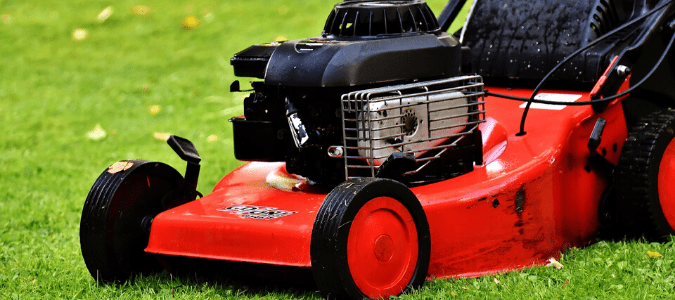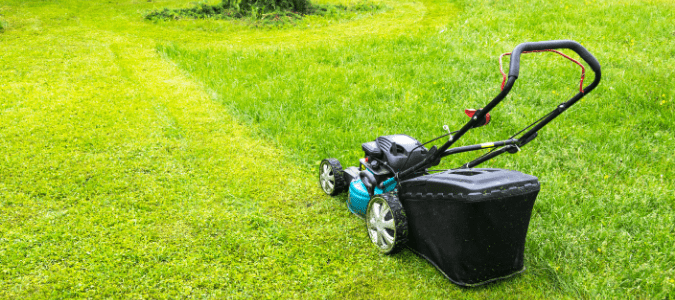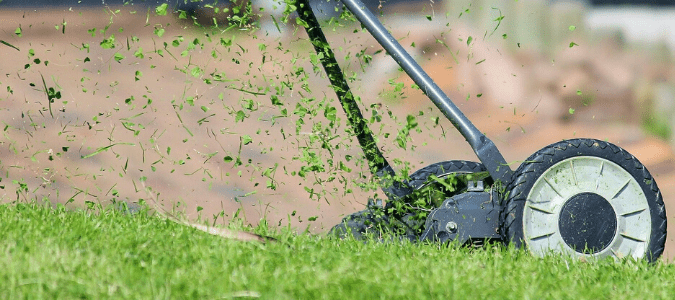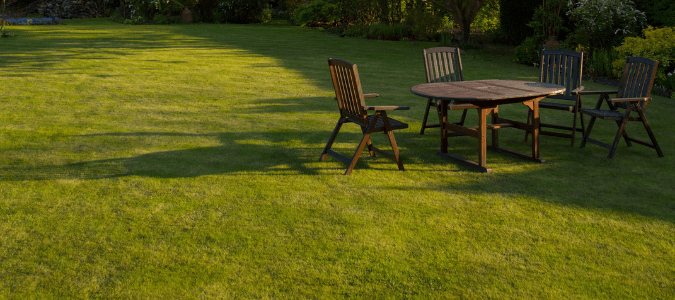
When caring for your outdoor spaces, one of the first considerations is how often you should mow your lawn. A number of factors will dictate the frequency of your mowing schedule, including the type of grass you have in your yard and the climate in your geographical region. As a general rule of thumb, during the colder portions of the year, when most varieties of grass go into their dormant phase, you shouldn’t have to mow your lawn often, if at all.
During the warmer seasons, however, you’ll need to mow regularly. For most yards, that means mowing once a week, or at least two to three times a month. The most important consideration when it comes to cutting your grass is how tall a healthy sprout is. Three of the most common grasses throughout the warmer regions of the United States are zoysia, St. Augustine and Bermuda grass and each variety should all be cut at different heights for optimal health.
The ideal heights are:
- Between two and a half and three inches tall for St. Augustine grass in sunny areas, and between three and three and a half inches tall in shady areas.
- One to two inches tall for Zoysia.
- One to two inches tall for Bermuda grass, unless it is a hybrid, in which case one and a half and two and a half inches tall is best.
Keeping your lawn lush and thriving during peak season can require lots of attention, energy and know-how. Different types of grass have various needs as far as sun or shade, moisture levels, fertilization and more. While some homeowners enjoy doing their own lawn care, treating it as an ongoing do-it-yourself project, many others opt to have a lawn care specialist deal with these chores. Hiring an experienced professional takes both the wondering and the actual physical work off your plate, so you can simply enjoy a green, neatly trimmed and thriving lawn.
If you want to try the do-it-yourself route first, you’ll want to learn more about when to fertilize, when to dethatch, when to mulch and other general tips for mowing your lawn.

Tips For Lawn Mowing
Many homeowners don’t realize that there is more to cutting your grass than just getting out the mower and pushing it across your yard when it starts to look too long. You’ll want to make sure you are not taking too much off your grass blades, that you are keeping your equipment in good working order and that you are mowing correctly and under the right conditions.
Don’t Cut Too Short
One of the most important rules for lawn mowing is not to cutting your grass too short. If you live in a warmer region with at least moderate rainfall, your grass might grow so quickly that it’s tempting to set the mower blade at its lowest setting so cut the grass as short as possible so you don’t have to mow as often, but this is usually a mistake. Grass produces most of its food via photosynthesis through its green blades, and if you cut your turf too short, the grass will begin to starve and show signs of stress by turning brown.
You might be able to get away with cutting your grass a bit shorter if you apply lots of extra water and fertilizer. For most people, however, it’s best to cut no more than one-third of the blades’ length at a time. If your grass has grown too long and cutting only a third of it won’t make it as short as you’d prefer, you can gradually shorten the mowing height over time by cutting your grass a couple of times a week for a few weeks.
Keep Your Blades Sharp And Mow In Different Patterns
Make sure to keep your mower’s blade sharp. As with most types of lawn equipment, as the blade of your mower is used, again and again, it will gradually become dull over time and make it harder to get the best results. In addition, experts will recommend that you mix up the pattern in which you mow your lawn. Naturally, grass grows in the direction in which it is getting cut, so by switching up your mowing pattern, you will allow your grass to grow upwards, as opposed to sideways.
Mow Under Optimal Conditions
Another piece of guidance is to mow only when your grass is dry. If you live in a rainy area, you may find it more challenging to find a good window for mowing, especially if your lawn rarely or never has time to dry out before the next shower begins. Even if you mow when it’s not actively raining, but the ground is still wet, you’ll have a harder time getting even, consistent results. The wet grass could also clump up in your mower, causing it to stall repeatedly. It’s also all too easy to dig ruts in the grass with the mower, since wet grass is so easy to pull out of mud by the roots. Worst of all, mowing a wet lawn can lead to fungal growth, which can damage your grass long-term. For a clean, even cut and to avoid damage both to your lawn and your mower, wait to mow until drier conditions.
In most regions of the country, there should be regular periods during peak growing season when there isn’t much rainfall, giving you time to mowy. In drier, more desert-like regions, this isn’t typically an issue, but it’s even more important to avoid cutting your grass too short. Grass handles both heat and drought better when it’s taller, rather than shorter; when these plants is allowed to grow a bit longer, the root structure grows deeper underground, which can also help prevent weed growth. This is desirable both from an aesthetic standpoint and in the sense that fewer weeds mean fewer plants competing for the water that the grass needs to thrive.
If you live in an area where the climate is hot, dry or both, be sure to water your lawn regularly, but only in the early morning, when less evaporation occurs. It’s also a good idea to avoid watering on windy days, as wind also increases evaporation. Bermuda and Zoysia are two varieties of grass that are highly heat and drought tolerant, making them a popular choice for homeowners in these areas. St. Augustine is another good choice for hot climates, although it does have higher watering and fertilization needs, as well as other St. Augustine grass problems. For many homeowners, especially those with lots of shade in their yard or any type of higher-maintenance lawn, hiring a professional lawn service is often the way to go to ensure that their outdoor spaces stay green and healthy.

When To Mulch Lawn Clippings
Mulching is great for lawns, as well as trees and flower beds, but many people aren’t sure when to mulch lawn clippings, or when to mulch the lawn in general. Here are a few tips on how to mulch your yard and what materials can be used for mulch.
One of the easiest ways to mulch your lawn is by leaving the grass clippings on the lawn after you mow rather than bagging them up, so you can return nitrogen and other important nutrients to the grass that is still growing. This works best on grass that is short to medium length. As long as the clippings are spread out evenly, rather than in clumps, they will be very beneficial to the grass, not to mention to your yard’s microbiome that includes worms, (friendly) bugs and beneficial bacteria.
You don’t want to leave clippings on your lawn as mulch when you have weeds. If you mowed down weeds along with your grass, bag those up and dispose of this yard waste so you don’t accidentally spread weed seeds across your landscape. If your grass is on the taller side, using clippings as mulch can prevent nutrients like nitrogen from reaching the roots and soil below. Leaves that fall during autumn and winter can also be used as mulch, although some types work better than others.
Once you have your mowing process and schedule down, you’ll want to learn more about other ongoing lawn maintenance tasks you can perform throughout the year.

When To Dethatch Your Lawn
Thatch is the bits and pieces of grass that die, turn a pale yellowy-brown color and collect at the base of growing grass blades, just above the surface of the soil. Having a thin layer of thatch in your yard is normal and benefits your landscape by protecting your grass’s roots from temperature extremes. When too much thatch builds up, however, air and moisture can’t reach the soil and roots. Knowing how and when to dethatch your lawn can help you avoid problems that occur when there’s more than a half-inch of thatch in your yard.
The best time to dethatch your lawn is when the earth is at least somewhat damp and the grass is in its active growth phase. This means spring for many warm-season grasses, including Bermuda, zoysia or St. Augustine, while early spring and fall for ryegrass or fescue.
Some signs that you have too much thatch buildup in your yard include a springy feeling when you walk across your grass, and not being able to easily poke a finger through the grass to the soil at its base. Lawns with too much thatch actually feel spongy to the touch, due to that thick layer that’s acting as a cushion-like barrier above the soil. As you might imagine, this layer prevents water and air from being able to circulate freely. Staying on top of your dethatching schedule is a great way to keep your lawn green in the summer heat.

How Often Should I Fertilize My Lawn?
While many people mow their lawns for aesthetic reasons, fewer fertilize regularly. This is an important aspect of lawn care, particularly since over-fertilizing is common and can both damage and add to your maintenance costs. In general, warm-season grasses, such as Bermuda, St. Augustine and zoysia, do well when fertilized in the early spring, since this is the best time to deliver plenty of needed nutrients before peak growing season. Testing your soil’s nutrient levels prior to fertilizing is very important to ensure you are purchasing the correct fertilizer and applying it in the right amounts at the right times. If creating a fertilization schedule yourself sounds too time intensive, you can always contact a lawn care specialist.
Bermuda Grass
For Bermuda grass, you’ll want to fertilize as the grass is turning green and after the last expected frost. Experts recommend applying a pound of nitrogen soluble fertilizer or a pound and a half of slow-release fertilizer for every 1,000 square feet of grass. You’ll need to apply the fertilizer every 8 to 10 weeks in the spring. Throughout the summer months, you’ll need to continually test your soil’s nutrients levels to determine whether and when to add additional nutrients. Depending on what you find, you may need to increase your fertilizing frequency to once every four weeks. As your lawn starts to go dormant, you’ll want to stop fertilizing so you don’t encourage the growth of weeds.
St. Augustine Grass
You should apply fertilizer to your St. Augustine grass three weeks after the blades have turned green and when there is little chance of another frost. If you decide to use a soluble nitrogen fertilizer, apply a pound of the product for every 1,000 square feet to your lawn once every 8 weeks. If you decide to use a slow-release fertilizer, you’ll need to plan to apply a pound and a half of it for every 1,000 square feet once every 10 weeks. You can continue with this fertilizing schedule throughout spring and summer, and cease applying more of the product once your lawn starts becoming dormant.
Zoysia Grass
Zoysia grass requires the smallest amount of fertilizer. You will only need to apply the product for the first time three weeks after your grass turns green. Depending on your lawn’s nutrient levels, apply either a half-pound or a pound of fertilizer per every 1,000 square feet. Keep in mind that you should never apply more than 3 pounds of fertilizer per 1,000 square feet to your lawn every year. Regularly test your soil’s nutrients levels throughout the year and apply additional fertilizer as necessary.
As we have already mentioned, the quickest, easiest and sometimes even most cost-effective way to take care of your lawn is to reach out to a professional lawn care service.
ABC Can Handle All Aspects Of Your Lawn Care Schedule
Spending your weekend on lawn care is not most people’s idea of fun. On top of that, lawns can be finicky and your lawn care schedule may need to be adjusted over time to best suit your particular lawn. The specialists at ABC Home & Commercial Services can take care of these ongoing tasks that will keep your lawn beautiful and green so that you can take advantage of a healthy, green landscape.
